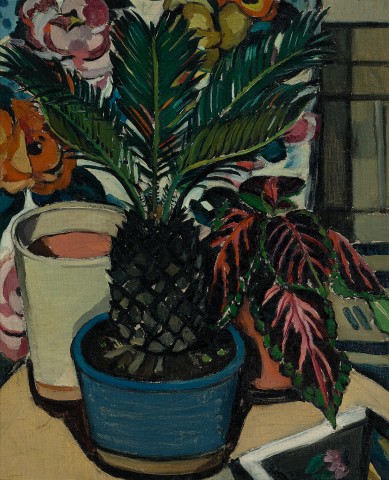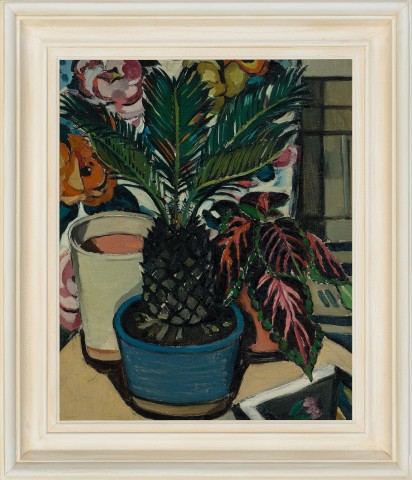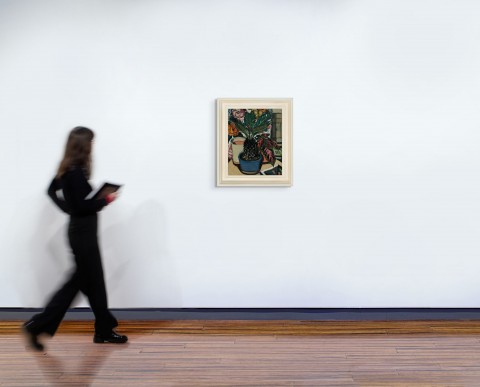PINEAPPLE PALM, 1925
MARGARET PRESTON
also known as STILL LIFE WITH PALM
oil on canvas
56.5 x 45.5 cm
Grosvenor Galleries, Sydney
Elioth Gruner, Sydney, acquired from the above in August 1929
with Grosvenor Galleries, Sydney, May 1940
Howard Hinton, Sydney, acquired from the above
Lawson’s, Sydney
Private collection, Sydney, acquired from the above, c.1970
Margaret Preston, Grosvenor Galleries, Sydney, 7 – 31 August 1929, cat. 6
Elioth Gruner Exhibition by Request of the Perpetual Trustee Co (Limited), Grosvenor Galleries, Sydney, 8 – 31 May 1940, no. 17 (as ‘Still life with Palm’)
Margaret Preston in Mosman, Mosman Art Gallery, Sydney, 7 September – 13 October 2002
Butler, R., The Prints of Margaret Preston: A Catalogue Raisonné, National Gallery of Australia, Canberra, 1987, p. 311
Margaret Preston Catalogue Raisonné of paintings, monotypes and ceramics, Art Gallery of New South Wales, Sydney, 2005, CD-ROM compiled by Mimmocchi, D., with Edwards, D., and Peel, R., cat. 1925.14 (illus.)
The Potted Plant, 1925, oil on canvas, 42.1 x 42.4 cm, in the collection of Benalla Art Gallery, Victoria, Ledger Gift in 1975
Strelitzia, 1925, oil on canvas, 45.7 × 53.9 cm, in the collection of the National Gallery of Victoria, Melbourne, bequest of Miss Leslie Henderson in 1982
Margret Ollie Stelitzia_cmyk copy.jpg
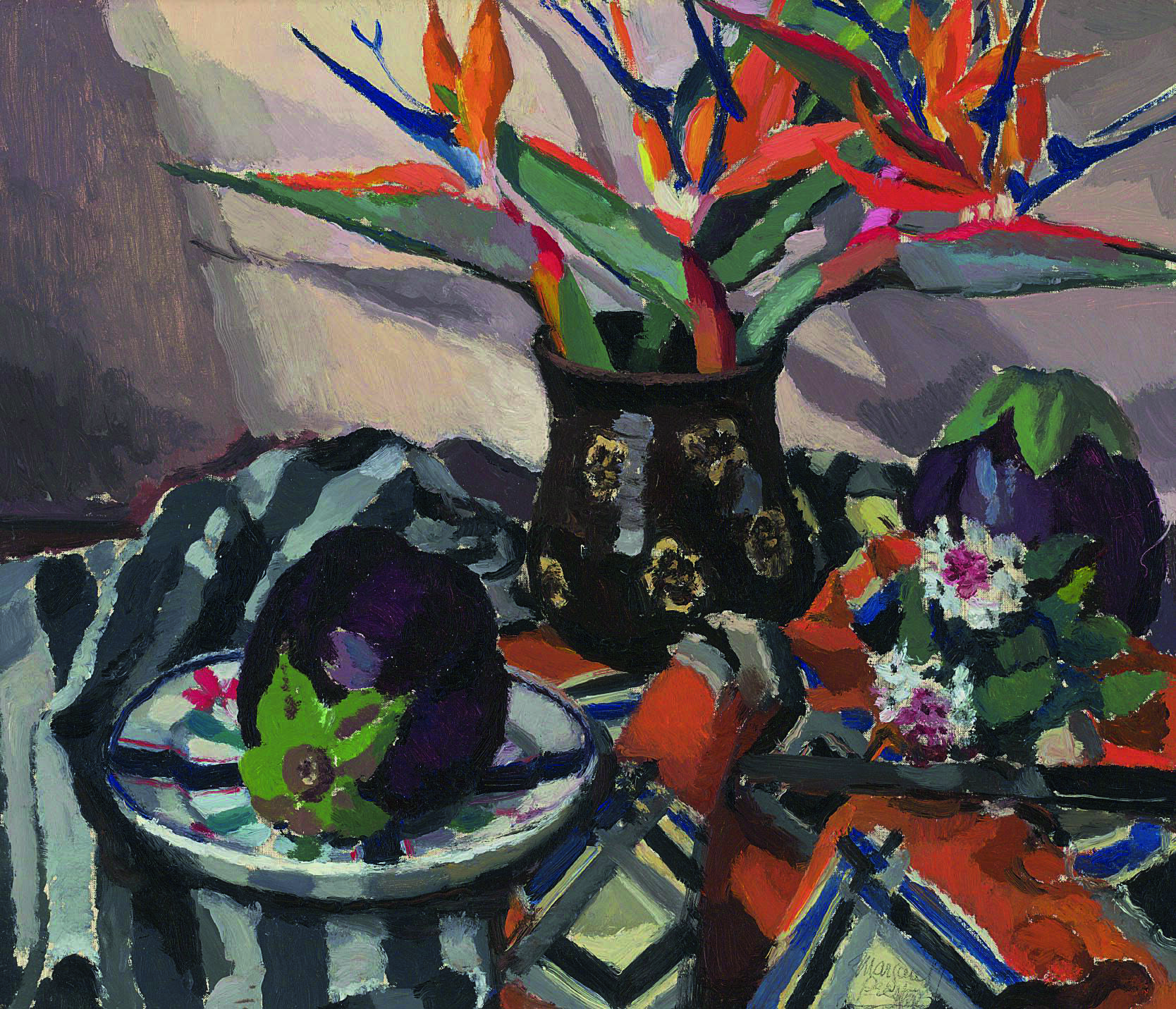
By 1925, when Pineapple Palm was painted, Margaret Preston’s long years of training and thought began to coalesce in her pursuit of a truly national Australian art. Ever the straight-talking pragmatist, she was wise enough to realise that this would be no overnight undertaking and instead set herself gradual exercises to reach her goal. Each was a finished work unto itself, but each was also an experiment analysing an aspect of her pursuit. In the words of her great supporter Sydney Ure Smith, publisher of Art in Australia, Preston was ‘the natural enemy of the dull,’1 an artist whose ‘refusal to repeat herself was because she had acquired a single aim which she knew had to be approached in stages – namely the discovery of forms which would eventually become the basis for an Australian natural art.’2 Taking her cues from Aboriginal design, modernist flattened abstraction, and Japanese art, she used still life as her ‘laboratory table’, a controlled space ‘on which aesthetic problems can be solved.’3
Preston had a rigorous traditional art training undertaken variously at the National Gallery School, Melbourne; the Munich Government School for Women; and at private academies in Paris and London. She slowly became attuned to the theoretical ideas underpinning the paintings of Paul Cézanne and took further inspiration from the Fernand Léger’s mechanised evocations of the modern world. Moreover, from her concurrent study of Japanese printmaking, Preston intuited these modern masters’ emphasis on shallow space and abrupt angles of view. However, her overarching inspiration was the art of Australia’s Indigenous population, whose pared-back symbols and aerial perspectives – so Preston believed – were the essential anchor for any art that attempted to express an authentically Australian identity. This understanding was outlined in her article ‘The Indigenous art of Australia’ published in Art in Australia in March 1925.4 Unfortunately, like most of Australia in those years, Preston neglected to inform herself of the deep spiritual attachment that the Indigenous have for their art, and her appropriations and experiments may jar with contemporary thought.
Pineapple Palm is, at first glance, an austere arrangement of draped fabric, flowerpots, the palm itself and a semi-obscured window – a partial view in the Japanese manner – but closer examination reveals the painting’s deliberate complexities. Preston takes obvious delight in the juxtaposition of the pineapple’s angular form and textural skin (surely a fruit designed solely for modernist art) set against an exotic floral fabric, likely one designed by Paul Poiret or Raoul Dufy, and imported by the David Jones’ store in 1924, with Preston enlisted to arrange their display. Apart from these blooms, the rest of the image incorporates muted, earthy colours akin to those utilised by Indigenous artists, and by tilting the table’s surface, she effectively reduces the space to a shallow plane. Notably, Pineapple Palm was first owned by Preston’s esteemed artist colleague Elioth Gruner5, and of the modest total of paintings known from 1925, a number are now part of respected institutional and corporate collections including Still life and Study in white (both National Gallery of Australia); Strelitzia (National Gallery of Victoria); Pink Hibiscus (Wesfarmers); The Potted Plant (Ledger Collection, Benalla Gallery); and White and Red Hibiscus (Art Gallery of South Australia).
Preston Potted Plant 1 cmyk copy.jpg
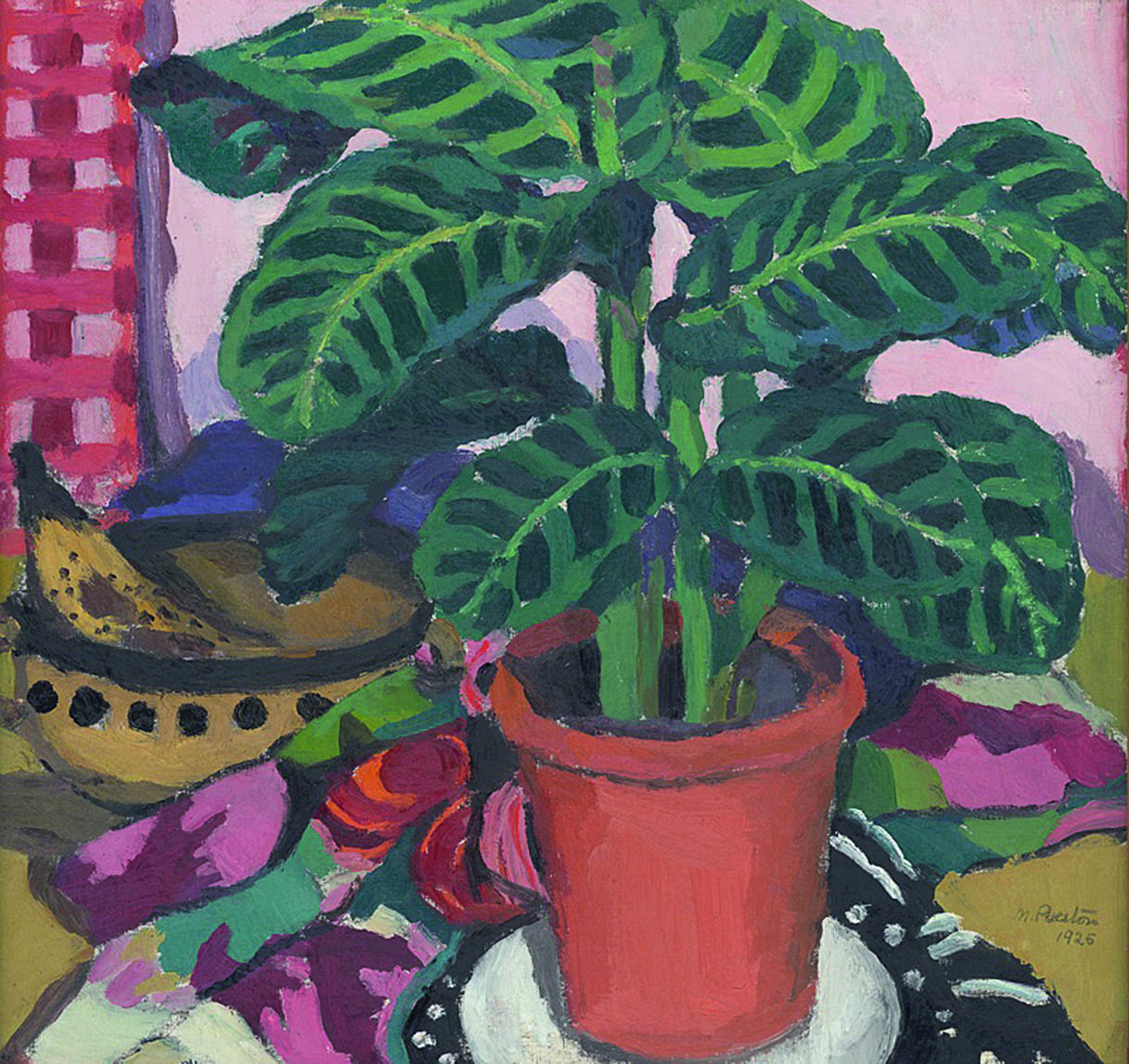
1. Ure Smith, S., ‘Editorial’, Art in Australia, Margaret Preston Number, 3rd series, no. 22, Art in Australia Ltd., Sydney, December 1927
2. McQueen, H., ‘Margaret Rose Preston – an enemy of the dull’, National U, Canberra, 13 June 1977, p. 23
3. Preston, M., ‘Aphorism 46’, in Gellert, L. and Ure Smith, S. (eds), Margaret Preston: Recent Paintings 1929, Art in Australia Ltd., Sydney, 1929
4. Preston, M., ‘The Indigenous art of Australia’, Art in Australia, 3rd series, no. 11, Art in Australia Ltd., Sydney, March 1925, n.p.
5. Other art colleagues who collected Preston’s paintings included Leon Gellert, Sydney Ure Smith, Lionel Lindsay, George Lambert, Thea Proctor and Adrian Feint.
ANDREW GAYNOR
